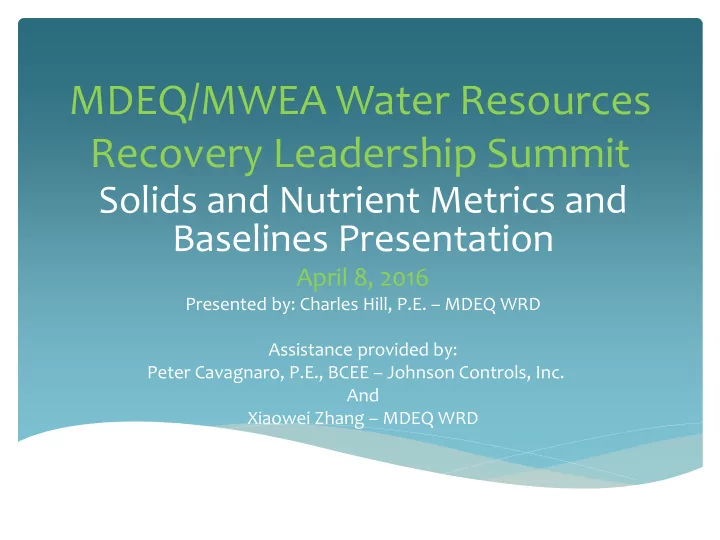

MDEQ/MWEA Water Resources Recovery Leadership Summit Solids and Nutrient Metrics and Baselines Presentation April 8, 2016 Presented by: Charles Hill, P.E. – MDEQ WRD Assistance provided by: Peter Cavagnaro, P.E., BCEE – Johnson Controls, Inc. And Xiaowei Zhang – MDEQ WRD
Michigan Governor’s Recycling Council http://www.michigan.gov/deq/0,4561,7-135-70153_69695-313206--,00.html
SIMILARITIES AND SYNERGIES BETWEEN LANDFILLS AND WASTEWATER FACILITIES Solid Waste Wastewater Treatment Build it / Use it / Renovate Build it / Use it / Close it Steady & predictable source of Relies on haulers bringing waste delivered to plant waste to the landfill Potential to generate biogas Generates biogas Recycling beneficially uses Recycling used to extend life nutrients, organics, and moisture 3 Bing Maps www.bing.com Bing Maps www.bing.com
WW Recycling in Michigan …. http://www.mlive.com http://www.michigan.gov/images/DVD_cove http://www.mi-wea.org/docs/Hannon%20- r_w_motto_127834_7.GIF %20Grandville%20Digester.pdf http://www.gvrba.org/sites/default/files/Logo1_1.png 4 http://www.mi-wea.org/docs/Williams- Lowell_Biomass_to_Energy.pdf
Utility of the Future WRRF WWTP Treat water to protect public Treat water to protect public health and the environment health and the environment Recover nutrients Optimize energy efficiency Produce energy Recover heat Water reuse Green infrastructure
MDEQ-WRD/MWEA Collaboration MDEQ-WRD and MWEA workgroup formed MWEA proposal Establish metrics & baselines Literature review Michigan WRRF Recycling Summit Recognition Program Outreach Program MDEQ-WRD Grant awarded
MI WW Recycling Metrics Solids Nutrients Nitrogen Phosphorus Energy
Please Note …. The numbers presented today are order of magnitude estimates The values will change as information is collected and methods of analysis are refined Assumptions used to generate the initial estimates are listed and are important to note 8
Solids Statewide biosolids annual report http://www.wilx.com/home/headlines/Authority-Honored- for-Cleaning-Up-Michigan-Landfills-204018441.html form information Annual report includes accounting of biosolids generated, land applied, solids disposed of by other means http://techalive.mtu.edu/meec/module21/Cost-WW.htm Determine % of total biosolids land applied or processed for other reuse applications (e.g. Detroit BDF project, compost, etc.) 9
Wastewater Solids Handling Techniques 2014 Land Applied Incinerated 24% 36% Composted 0% Two plants compost - Values Included with Land Application Landfilled 40% 10
WW Recycling Estimates – Solids 2014 Est. of Biosolids Recycling Given: Total Biosolids Land Applied = 80,897 dry tons/year Total Biosolids Composted = dry tons/year - Total Solids Landfilled = 135,622 dry tons/year Total Solids Incinerated = 120,995 dry tons/year Total Solids Disposed = 337,514 dry tons/year Assumptions: Percent of solids captured via treatment = 90% First Estimate (Order of Magnitude): Total Biosolids Recycled = 80,897 dry tons/year 2014 Est. % Biosolids Recycled = 22% 11
Wastewater Solids Handling Techniques 2015 Incinerated Land Applied 35% 25% Composted 0% Two plants compost - Values Included with Land Application Landfilled 40% 12
WW Recycling Estimates – Solids 2015 Est. of Biosolids Recycling Given: Total Biosolids Land Applied = 75,845 dry tons/year Total Biosolids Composted = dry tons/year - Total Solids Landfilled = 123,681 dry tons/year Total Solids Incinerated = 106,453 dry tons/year Total Solids Disposed = 305,979 dry tons/year Assumptions: Percent of solids captured via treatment= 90% First Estimate (Order of Magnitude): Total Biosolids Recycled = 75,845 dry tons/year 2015 Est. % Biosolids Recycled = 22% 13
Nutrients Estimate nutrient load to municipal WWTPs Assumptions: Detroit (~600 MGD) is half municipal discharge in the state…1200 MGD total Influent Total Phosphorus (5 mg/L) Influent TKN (25 mg/L) Estimate nutrient load to receiving water Assumption: 90% nutrient removal via treatment Estimate the amount of nutrients captured in solids 14
WW Recycling Estimates – Nutrients Est. of Municipal WWTP Surface Water Discharges and Nutrient Loadings Given: DWSD discharge 600 MGD Assumptions: DWSD as a % of municipal surface water discharge ~ 50% in the state Influent TKN (est.) 25 mg/L Influent P (est.) 5 mg/L First Estimate (Order of Magnitude): Est. Annual Muni WWTP Surface Water Discharge = 438,000 MGY Est. Annual Muni WWTP Nitrogen loading = 91,323,000 lbs/yr Est. Annual Muni WWTP Phosphorus loading = 18,264,600 lbs/yr 15
WW Recycling Estimates – Nutrients Nutrient Recycling Rate Estimates – 2014/15 Given: 2014 Biosolids data: dt/yr 80,897 Statewide Land App 2015 Biosolids data: dt/yr 75,845 Statewide Land App From 2014 Data (statewide averages): Nitrogen (N, % of TS) 3.8% Phosphorus (TP, % of TS) 1.9% Assumptions: Percent removal of solids via treatment process = 90% 16
WW Recycling Estimates – Nutrients Nutrient Recycling Rate Estimates – 2014/15 First Estimate (Order of Magnitude): 2014 2015 Annual Biosolids Land Applied (2014) = dt/yr 80,897 75,845 Est. Annual Nitrogen Land Applied = dt/yr 3,074 2,882 Est. Annual Phosphorus Land Applied = dt/yr 1,537 1,441 Est. Annual Nitrogen Recycled = 6% 6% Est. Annual Phosphorus Recycled = 15% 14% 17
WW Recycling Estimates – Nutrients Nutrient Recycling Rate Estimates – with Detroit BDF Detroit Biosolids Dryer Facility (BDF) Pelletizes solids from wastewater treatment process ~315 dtpd capacity At full operation on a daily basis, the Detroit BDF would more than double current nutrient recycling rates: Est. Annual Nitrogen recycled from ~6% to ~15% Est. Annual Phosphorus recycled from ~15% to ~35%
Data Discrepancies Actual solids data and associated Phosphorus concentrations show that nutrient loading estimates are ~ 20-25% higher than can be accounted for As actual loading data becomes available, we expect that this discrepancy will decrease
Goals Solid Waste Recycling Goal is to double recycling rate from 15% to 30% in 2 years Wastewater Recycling Goal to be similar? Ultimately, maximize beneficial reuse Continue to promote and encourage such efforts
Thank You Charles Hill, PE MDEQ – WRD hillc@michigan.gov 906-228-4527
Recommend
More recommend